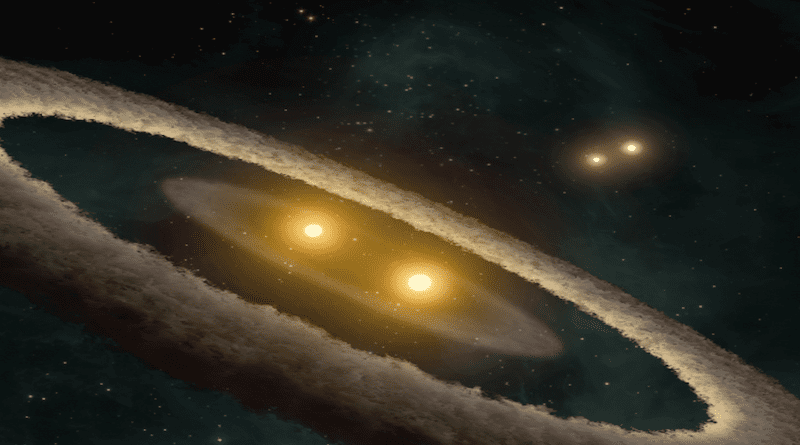Compact, Massive Triple Star System Detected For First Time
The detection of an unusually compact “one of a kind” system of three stars was announced earlier this year. The question about how this unique combination of a binary set of stars and a revolving bigger star can form is now the focus in a collaboration between two young researchers at the Niels Bohr Institute at the University of Copenhagen.
Tertiary star formation on a massive scale
The star system consists of a binary set of stars – two stars that orbit one another and then one, more massive star orbiting the binary.
“As far as we know, it is the first of its kind ever detected”, Alejandro Vigna-Gomez says. “We know of many tertiary star systems (three star systems), but they are typically significantly less massive. The massive stars in this triple are very close together – it is a compact system.
The orbital period of the binary (~1 d) is the same as that of the rotation of Earth (1 day).
The combined mass of the two of them is twelve times the mass of our Sun – so rather big stars.
The tertiary star is approximately 16 times the mass of our Sun, so even bigger! The inner orbit is circular in shape with close to six revolutions of the tertiary star around the binary per year. Pretty fast, when you consider the size of them – unsurprisingly, the system is very luminous, so at first they were detected as a stellar binary”.
The dedication of amateurs led to the discovery of the star system
The initial discovery of the unique nature of this very special system is also special in the way that it was made by amateur astronomers.
A community of amateur astronomers, who were going through a public data set from NASA’s TESS observatory (Transiting Exoplanet Survey Satellite) and found something a bit out of the ordinary.
The level of professionalism can be quite high among amateurs, and they made the professional astronomers aware of anomalies in the detection. It turned out that what was previously believed to be two stars, were actually three.
Communities like these are called citizen scientists.
The combination of expertise on dynamics and stellar evolution proved to be fruitful
Post doc Alejandro Vigna–Gomez explains that when investigating the formation of the star system, several options were considered.
- If, for instance, the bigger star formed first, it would likely have ejected material that would have disrupted the formation of a binary that close.
- Another possibility is that the binary and the third star formed separately from each other and eventually encountered and locked in their orbits because of gravity.
- – or a third possibility, where two binaries formed and one merged into one, bigger star.
This is where the combined efforts of Bin Liu, expert on dynamics and Alejandro Vigna-Gomez’ knowledge on star formation came in handy.
They coded the options and ran more than 100.000 iterations on the computer, in order to assess the most likely outcome of this scenario.
The result turned out to be in favor of the two binary systems forming initially and one of them merging to one star. Their results show that the two binary scenario could in fact explain the origin of the triple system.
The way forward requires the expertise of an astronomer specializing in observations
“Now we have a model of the most likely scenario on this unique system. But a model is not enough.
And there are two ways in which we can prove or disentangle our theory on this formation”, postdoc Alejandro explains. ”One is studying the system in detail and the other is to make a statistical analysis on a population of stars.
If we go to the system in detail, we shall have to rely on the expertise of an astronomer. We already have some preliminary observations, but we still need to go through the data, and make sure we are interpreting it well”.
Bin Liu continues: “We also encourage people in the scientific community to look at the data deeply”, Postdoc Bin Liu says. “Maybe there are more compact systems buried in the data. What we really want to know is whether this kind of system is common in our universe”.
Alejandro Vigna-Gomez and Bin Liu have now mapped out quite a lot of work for themselves. “We need to find an adequate telescope with available observing time somewhere in the world, and talk to someone who is really an expert from the observational point of view.
The data from telescopes needs to be understood correctly. What you see in a telescope is not entirely what you get, so to say. It must be interpreted”. So more collaboration is underway, very much in the spirit of Niels Bohr, Alejandro says:
“A Chinese and a Mexican with each their different fields, dynamics and star formation, meet at the Niels Bohr Institute and now on the way to yet more scientific collaboration”.

